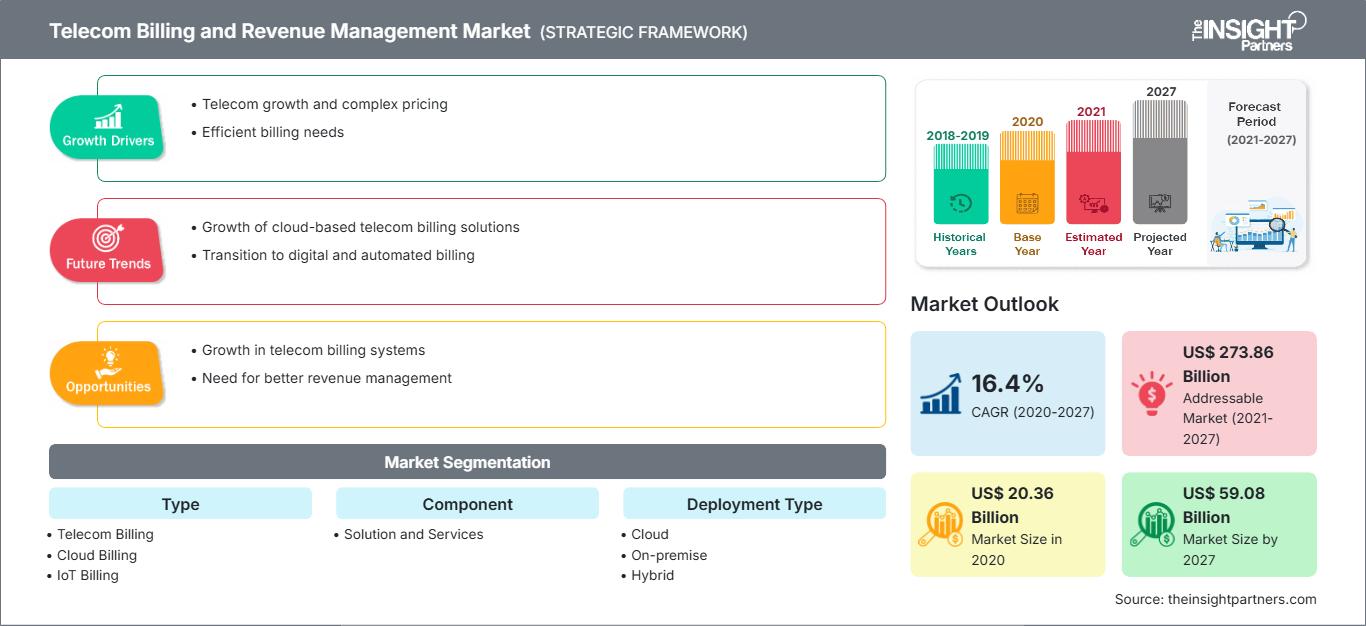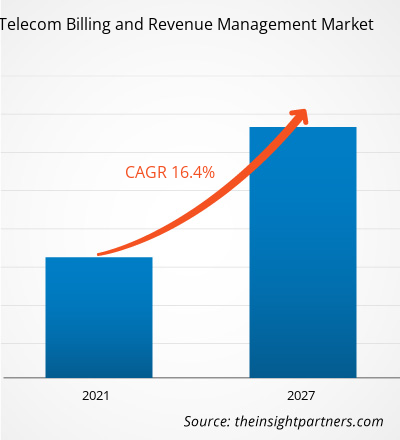Se espera que el mercado de facturación y gestión de ingresos de telecomunicaciones crezca de US$ 20.362,5 millones en 2020 a US$ 59.075,4 millones en 2027; se estima que crecerá a una CAGR del 16,4% entre 2020 y 2027.
La creciente demanda de soluciones y servicios innovadores de facturación y gestión de ingresos contribuye al crecimiento del mercado. La constante necesidad de ofrecer servicios de comunicación de alta calidad y experiencias de cliente optimizadas impulsa a los proveedores de soluciones y servicios de facturación y gestión de ingresos de telecomunicaciones a desarrollar aún más estas soluciones y servicios, compatibles y a la altura de las necesidades y demandas dinámicas de los usuarios finales, con mayor escalabilidad, flexibilidad y funcionalidad. Las soluciones eficientes y flexibles de facturación y gestión de ingresos ayudan a los proveedores de servicios de comunicaciones (CSP) a monetizar aún más el uso de datos y servicios, proporcionándoles capacidades mejoradas de análisis de datos en tiempo real y mayor eficiencia para canalizar sus flujos de ingresos mediante soluciones personalizadas. También ayudan a los CSP a gestionar eficientemente los crecientes procesos de facturación y cobro de sus suscriptores a través de una plataforma única y eficaz.
Además, ayuda a las empresas y les brinda la confianza para implementar nuevas ofertas personalizadas, servicios generadores de ingresos y políticas de cobro rápidamente con mayor eficiencia, además de monetizar sus inversiones en infraestructura, optimizando la gestión de clientes e ingresos. Los CSP actualizan continuamente sus sistemas heredados mediante la incorporación de plataformas que les ayudarán a dar servicio a una base de suscriptores más amplia y a migrar a soluciones y servicios en la nube como SaaS, lo que les permitirá reducir el CAPEX y optimizar el OPEX. Asimismo, el aumento de las tendencias de gasto y los requisitos en soluciones como BSS/OSS también está acelerando el crecimiento del competitivo mercado global de facturación y gestión de ingresos de telecomunicaciones.
Impacto de la pandemia de COVID-19 en el mercado de facturación y gestión de ingresos de telecomunicaciones
La crisis de la COVID-19 tuvo un impacto positivo en el crecimiento de algunos sectores, como las TI y las telecomunicaciones. La demanda de servicios digitales, en particular, ha crecido a un ritmo elevado en los últimos meses. Sin embargo, se prevé que la disminución de actividades comerciales, como las alianzas para impulsar la adopción de soluciones de facturación y gestión de ingresos de telecomunicaciones en diversos países, afecte negativamente al crecimiento de la expansión de los proveedores de facturación y gestión de ingresos de telecomunicaciones. Por lo tanto, se producirá un impacto mixto, lo que provocará una ligera caída del crecimiento en 2020 y 2021.
Obtendrá personalización en cualquier informe, sin cargo, incluidas partes de este informe o análisis a nivel de país, paquete de datos de Excel, así como también grandes ofertas y descuentos para empresas emergentes y universidades.
Mercado de facturación y gestión de ingresos de telecomunicaciones: perspectivas estratégicas

-
Obtenga las principales tendencias clave del mercado de este informe.Esta muestra GRATUITA incluirá análisis de datos, desde tendencias del mercado hasta estimaciones y pronósticos.
Perspectivas del mercado: mercado de facturación y gestión de ingresos de telecomunicaciones
Creciente preferencia por soluciones y servicios basados en la nube
Los operadores de telecomunicaciones y los proveedores de servicios de comunicaciones (CSP) de todo el mundo se enfrentan a la complejidad de gestionar sus sistemas, escalar su infraestructura de red y atender a una base de consumidores cada vez mayor. Lograr una alta eficiencia operativa, junto con una mejor gestión y recaudación de ingresos, es una de las principales prioridades y requisitos para los operadores de telecomunicaciones y los CSP. Las soluciones de facturación eficientes basadas en la nube facilitan a los operadores de telecomunicaciones y a los CSP la monitorización eficaz del uso del servicio por parte de los suscriptores, según sus planes de servicio, y la facturación correspondiente. Ayudan a los CSP a gestionar sus pagos y cuentas, y les ayudan a construir, planificar y optimizar sus redes, a la vez que ayudan a las empresas a gestionar un gran número de transacciones simultáneas y solicitudes de clientes.
Una de las mayores ventajas que ofrecen las soluciones y servicios en la nube, como SaaS, a los operadores de telecomunicaciones y proveedores de servicios de comunicaciones (CSP) es su bajo coste inicial de inversión. Ayuda a las empresas a reducir la inversión en infraestructura y los esfuerzos de integración, proporcionándoles facilidades como el modelo de pago por uso, que también les permite probar nuevas soluciones con bajo riesgo. Además, modelos de servicios como SaaS ofrecen a los operadores de telecomunicaciones y CSP la capacidad de implementar y dar soporte rápidamente a servicios nuevos y existentes, lo que ayuda a las empresas a entrar en nuevos mercados de forma más rápida, económica y con mayor flexibilidad.
Información basada en componentes
Según sus componentes, el mercado de facturación y gestión de ingresos de telecomunicaciones se segmenta en soluciones y servicios. Los segmentos de soluciones obtuvieron la mayor cuota de mercado en 2019.
Los actores que operan en el mercado de facturación y gestión de ingresos de telecomunicaciones se centran principalmente en el desarrollo de productos avanzados y eficientes.
- En 2020, TDC, operador con sede en Dinamarca, eligió a Comarch SA para ofrecer sus soluciones BSS. La empresa ofreció a TDC su sistema de gestión de pedidos de clientes, su sistema de facturación convergente y su plataforma de integración de aplicaciones.
- En 2020, Telecom Fiji Limited, proveedor de servicios de telefonía, colaboró con Oracle Communications para optimizar la interacción con los clientes y agilizar la entrega de productos y servicios. La empresa implementará la gestión de facturación e ingresos de Oracle como parte de la suite Oracle Digital Experience for Communications para facilitar una experiencia digital al cliente.
El mercado de facturación y gestión de ingresos de telecomunicaciones se ha segmentado de la siguiente manera:
Mercado de facturación y gestión de ingresos de telecomunicaciones (por componente)
-
Solución
- Gestión de facturación
- Gestión de cuentas
- Otros
-
Servicios
- Servicios profesionales
- Servicios gestionados
Mercado de facturación y gestión de ingresos de telecomunicaciones: por tipo
- Facturación de telecomunicaciones
- Facturación en la nube
- Facturación de IoT
Mercado de facturación y gestión de ingresos de telecomunicaciones: por tipo de implementación
- Local
- Basado en la nube
- Híbrido
Mercado de facturación y gestión de ingresos de telecomunicaciones por geografía
-
América del norte
- A NOSOTROS
- Canadá
- México
-
Europa
- Francia
- Alemania
- Italia
- España
- Reino Unido
- Resto de Europa
-
Asia Pacífico (APAC)
- Japón
- Porcelana
- Australia
- India
- Resto de APAC
-
Oriente Medio y África (MEA)
- Emiratos Árabes Unidos
- Dubái
- Arabia Saudita
- Katar
- Sudáfrica
- Etiopía
- Ruanda
- Kenia
- Costa de Marfil
- Ghana
- Nigeria
- Egipto
- Marruecos
- Túnez
- Pavo
- Resto de MEA
-
América del Sur (SAM)
- Brasil
- Argentina
- Chile
- Perú
- Colombia
- Resto de SAM
Perspectivas regionales del mercado de facturación y gestión de ingresos de telecomunicaciones
Los analistas de The Insight Partners han explicado detalladamente las tendencias y los factores regionales que influyen en el mercado de facturación y gestión de ingresos de telecomunicaciones durante el período de pronóstico. Esta sección también analiza los segmentos y la geografía del mercado de facturación y gestión de ingresos de telecomunicaciones en Norteamérica, Europa, Asia Pacífico, Oriente Medio y África, y Sudamérica y Centroamérica.
Alcance del informe de mercado sobre facturación y gestión de ingresos de telecomunicaciones
| Atributo del informe | Detalles |
|---|---|
| Tamaño del mercado en 2020 | US$ 20.36 mil millones |
| Tamaño del mercado en 2027 | US$ 59.08 mil millones |
| CAGR global (2020-2027) | 16,4% |
| Datos históricos | 2018-2019 |
| Período de pronóstico | 2021-2027 |
| Segmentos cubiertos |
Por tipo
|
| Regiones y países cubiertos |
América del norte
|
| Líderes del mercado y perfiles de empresas clave |
|
Densidad de actores del mercado de facturación y gestión de ingresos de telecomunicaciones: comprensión de su impacto en la dinámica empresarial
El mercado de facturación y gestión de ingresos de telecomunicaciones está creciendo rápidamente, impulsado por la creciente demanda de los usuarios finales debido a factores como la evolución de las preferencias de los consumidores, los avances tecnológicos y un mayor conocimiento de los beneficios del producto. A medida que aumenta la demanda, las empresas amplían su oferta, innovan para satisfacer las necesidades de los consumidores y aprovechan las tendencias emergentes, lo que impulsa aún más el crecimiento del mercado.

- Obtenga una descripción general de los principales actores clave del mercado de gestión de ingresos y facturación de telecomunicaciones
Mercado de facturación y gestión de ingresos de telecomunicaciones: perfiles de empresas
- Accenture PLC
- Alcatel-Lucent SA
- Amdocs, Inc.
- Cerillion PLC
- CSG Systems Internacional, Inc.
- Ericsson
- goTransverse International, Inc.
- Compañía de desarrollo Hewlett-Packard LP
- Huawei Technologies Co., Ltd.
- Corporación NEC
- Corporación Oracle
- Redknee, Inc.
- SAP SE
- XURA
- Panamax
- stl.tech
- Comviva
- Redes Enghouse
- Fiserv, Inc.
- Corporación Vcare
- Énfasis
- Agilidad CIS
- ESCADENIA
- Descifrador de redes
- Análisis histórico (2 años), año base, pronóstico (7 años) con CAGR
- Análisis PEST y FODA
- Tamaño del mercado, valor/volumen: global, regional y nacional
- Industria y panorama competitivo
- Conjunto de datos de Excel
Informes recientes
Informes relacionados
Testimonios
Razón para comprar
- Toma de decisiones informada
- Comprensión de la dinámica del mercado
- Análisis competitivo
- Información sobre clientes
- Pronósticos del mercado
- Mitigación de riesgos
- Planificación estratégica
- Justificación de la inversión
- Identificación de mercados emergentes
- Mejora de las estrategias de marketing
- Impulso de la eficiencia operativa
- Alineación con las tendencias regulatorias






















 Obtenga una muestra gratuita para - Mercado de facturación y gestión de ingresos de telecomunicaciones
Obtenga una muestra gratuita para - Mercado de facturación y gestión de ingresos de telecomunicaciones